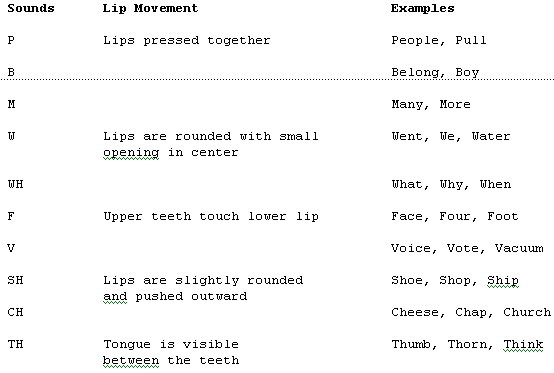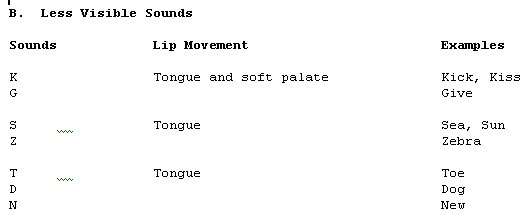The progress made over the last decade in cochlear implants, surgical techniques, and speech processing strategies has been phenomenal. There has been vast improvement in functional outcomes when comparing early single channel devices, which provided basic speech awareness and improved speechreading ability, to current digitally-based technology, where open-set speech recognition no longer amazes the clinician. With improved technology and outcomes, some assume the adult cochlear implant user no longer requires audiologic rehabilitation.
Is it appropriate to omit audiologic rehabilitation because the patient is "doing pretty good" without training? Is "good enough" adequate, when additional rehabilitative procedures could insure that the patient is performing at his or her optimal level?
We believe effective treatment must consider the effect of the hearing impairment upon the individual and the people with whom he/she interacts. The following assumptions are the basis of our audiologic rehabilitation program:
A rehabilitation program will contribute to cochlear implant users reaching their full potential. The nature and content of rehabilitation programs will vary with each individual, but even those with excellent performance following initial stimulation may benefit from a rehabilitation program designed for their needs.
In many cases, additional counseling, education, training in perceptual skills, and training in the dynamics of communication facilitate the individual's independent management of their hearing impairment to improve communication skills.
Implantation results in dramatic changes in communication function, interpersonal communication and relationships, and environmental awareness. Information, guidance and support facilitate the individual's transition from being "deaf" to being "hard of hearing."
The sudden change in hearing ability, which results from implantation affects the patient, his/her family, friends, and co-workers. The rehabilitation process is quickened and the opportunities for success are improved if these individuals are involved. Information enhances the patient's and the communication partners' understanding of the benefits and limits of implantation and the recognized factors in listening environments that can have predictable effects on performance.
Recommended Activities:
A variety of materials and activities will assist the clinician in providing customized rehabilitative programs for the implant user and their family members. Some activities are designed to be used with groups of cochlear implant users, others are to be used with mixed groups of cochlear implant and hearing aid users. Family members are encouraged to participate.
Sample material related to Telephone Use, Communication Strategies, Speechreading and Auditory Training are noted below.
I. Telephone Issues:
Phone use is a special challenge for anyone with hearing loss, and this is particularly true of cochlear implant users. Some patients may begin using the phone for the first time, while others may be re-introduced to telephones after not using them for a long time. Practice can make using the phone easier for most implant users.
A. Notes for the Patient:
Talk face-to-face with friends, co-workers, and family members about using the phone. Teach them the best way to speak to you. If they understand what the cochlear implant can and can't do, they will more likely remember to speak the way you need them to. Ask them to help you with practice exercises in the guide. This may help them understand your new hearing status. Strangers who call are usually more challenging. If you have difficulty understanding strangers, tell them you have hearing loss. Tell them what you need (slower speech, etc).
B. Telephone Hints for the Patient:
Develop the skill of making specific suggestions to callers. Rather than simply saying "Sorry, I didn't hear that." If you find yourself in a bind, try some of these examples:
C. Telephone Hardware Hints:
D. Things to think about when preparing to master telephone use:
Some cochlear implant users notice that they can't recognize a person's voice over the phone; everyone sounds the same. If this is so, tell the people you speak with regularly that you need them to begin each phone call by stating their name.
Voices that are too loud or too soft may be difficult for the cochlear implant to process. Teach the people who call regularly how loud you need them to speak over the phone. Let them know when their voice is just right.
Speaking slowly and clearly is helpful over the phone, but many people, talk very fast. Ask people to slow down and let them know when their rate is just right for you.
E. Background Noise:
Keep in mind that background noise will interfere with understanding. The speech processor will choose the loudest signal to send to your ear. You may need to turn down noise near the phone, or ask the caller to do the same before you can understand.
F. Double-check details:
It is important to confirm your understanding of important details over the phone. Dates, times, names, addresses, etc., require accurate understanding. Get into the habit of double-checking details of conversations so you and person you are speaking with will know these details have been successfully communicated.
II. Communication Strategies
Communication will be a challenge during the first days and months following initial stimulation for the implant user and the people they interact with. Sound will be different and it will take time for the implant user to adjust.
A. Ways in which family members can assist:
B. Tips for the cochlear implant and hearing aid patient to improve communication. There are many things individuals can do to take advantage of their state-of-the-art cochlear implants or hearing aids. Certain techniques go a long way in reducing communication and interpersonal challenges.
III. Speechreading:
Everyone "speechreads" or "lipreads" a little. Most people with normal hearing don't think about speechreading, and they naturally do it to enhance communication. For hearing impaired and deaf people, speechreading is a valuable asset that adds terrific insight into the communication event. Practicing speechreading helps you take full advantage of visual clues.
If the person speaking to another who is hearing impaired selects workds with the more visible sounds, understanding will be improved.
A. Sounds to Look For When Speechreading
The chart below outlines the visibility of different consonant sounds.
Most Visible Sounds


IV. Auditory Training
Raymond Carhart described auditory training as the "process of teaching the child or adult who is hard of hearing to take full advantage of sound cues which are still available to him/her" (Chermack, p 146). Combining auditory and visual cues will usually optimize communication. Auditory training will assist the person with hearing loss to use his residual hearing to the fullest.
Sound may be heard, but it must have meaningful association to be understood. It must be related to people, objects, events, and ideas. Auditory training should involve the use of meaningful dialogue representative of the messages an individual will encounter in their academic, work, home, and social environment. Programs must emphasize practice in daily situations in which the participants' auditory comprehension is challenged. Such training should include listening, decision making, and responding to representative speech messages.
A. Levels of auditory training include:
B. Lessons should include:
CONCLUSION:
You have now reviewed a few samples of the many practical materials included in our book for cochlear implant users. We hope these help you guide your patients to get the most out of their implant technology.
With work, time, practice and patience, every cochlear implant patient can gain improved communication function. Even those who have worn their speech processors for long periods can realize improvement in communication effectiveness by following some of the guidelines noted above. Learning to take full advantage of the potential of the device is a continuing process. Encourage your patients to recognize this. Suggest that your patients and their significant others work together to become better communicators.
Good luck in this exciting adventure of facilitating improved communication for your patients who use cochlear implants, their families and friends. It is a privilege to act as a facilitator in this endeavor. We welcome your comments and suggestions via e-mail to: hearagain@jump.net.
Recommended groups and associations:
Cochlear Implant Club International (CICI)
5335 Wisconsin Avenue., Suite 440
Washington, DC 20015-2034
(202) 895-2781
Self Help for Hard of Hearing People, Inc. (SHHH)
7901 Woodmont Avenue, Suite 1200
Bethesda, MD 20914
(301) 657-2248 (Voice)
(301) 657-2249 (TTY)
Association of Late Deafened Adults (ALDA)
2600 W. Peterson Avenue., Suite 202
Chicago, IL 60659
Recommended readings:
Biderman, B. (1998). Wired for Sound, Trifolium Books, Inc., Toronto, Ontario, Canada
Chermack, G.D. (1981). Handbook of Audiological Rehabilitation, Springfield, IL: Charles C. Thomas.
Dugan, Marcia (1997). Keys to living with hearing loss, Bethesda, MD: SHHH Publications.
Erber, Norman, (1993). Communication and adult hearing loss, Abbotsford, Victoria, Australia: Clavis Publishing
Pope, Ann (1997). Hear: Solutions, skills and sources for people with hearing loss, Bethesda, MD: SHHH Publications
Romoff, A. (2000). Hear Again: Back to Life with a Cochlear Implant, League for Hard of Hearing Publication, New York, NY
Wayner, Donna S, (1998). Hear what you've been missing: How to cope with hearing loss, New York, NY: John Wiley Publishing
Wayner, D.S. and Abrahamson, J.E., (1998). Learning to Hear Again with a Cochlear Implant; Clinician Manual; A Personal Journal; User's Guide, Latham, NY: Hear Again, Inc.
Recommended publication sources:
A.G. Bell Association for the Deaf
3417 Volta Place, NW
Washington, DC 20007-2778
(202) 337-5220 (Voice/TTY)
SHHH Publications
7910 Woodmont
Bethesda, MD 20814
(301) 657-2248 (Voice)
(301) 657-2249 (TTY)
Hear Again, Inc.
37 Grandview Drive
Latham, New York 12110
(518) 786-3573
Life After Deafness
6773 Starboard Way
Sacramento, CA 95831-2413
(916) 392-5750 (Fax)
NIDCD Information Clearinghouse
National Institute on Deafness & Other Communication Disorders
National Institute of Health
1 Communication Avenue
Bethesda, MD 20892-3456
(800) 241-1044 (Voice)
(800) 241-1055 (TTY)
Recommended Audio Books
Books on Tape, Inc.
(offers unabridged books on tape for rent)
(800) 252-6996
Educational Records Center
(offers a six cassette tape set, The Definitive Encyclopedia of Sound Effects, for sale)
(800) 438-1637
Micro Sound Product (offers a four CD set, Sound Effects, for sale)
(707) 347-7662
Recommended Internet Sites:
www.bionicear.com
www.healthyhearing.com
www.hearagainpublishing.com
www.nih.gov/health
ACKNOWLEDGEMENTS:
A previous version of this article was published by Advanced Bionics, in their publication titled : Loud and Clear! An Advanced Bionics Corporation Publication Vol.3 Issue2. Much of the information presented here is from the Wayner and Abrahamson book titled: "Learning to Hear Again with a Cochlear Implant: An Audiologic Rehabilitation Guide" published by Hear Again in 1998.
We are grateful to the authors, the original article editor (Amy McConkey Robbins, M.S., CCC-SP) and Advanced Bionics for allowing us to revise and publish this article. --- Editor

